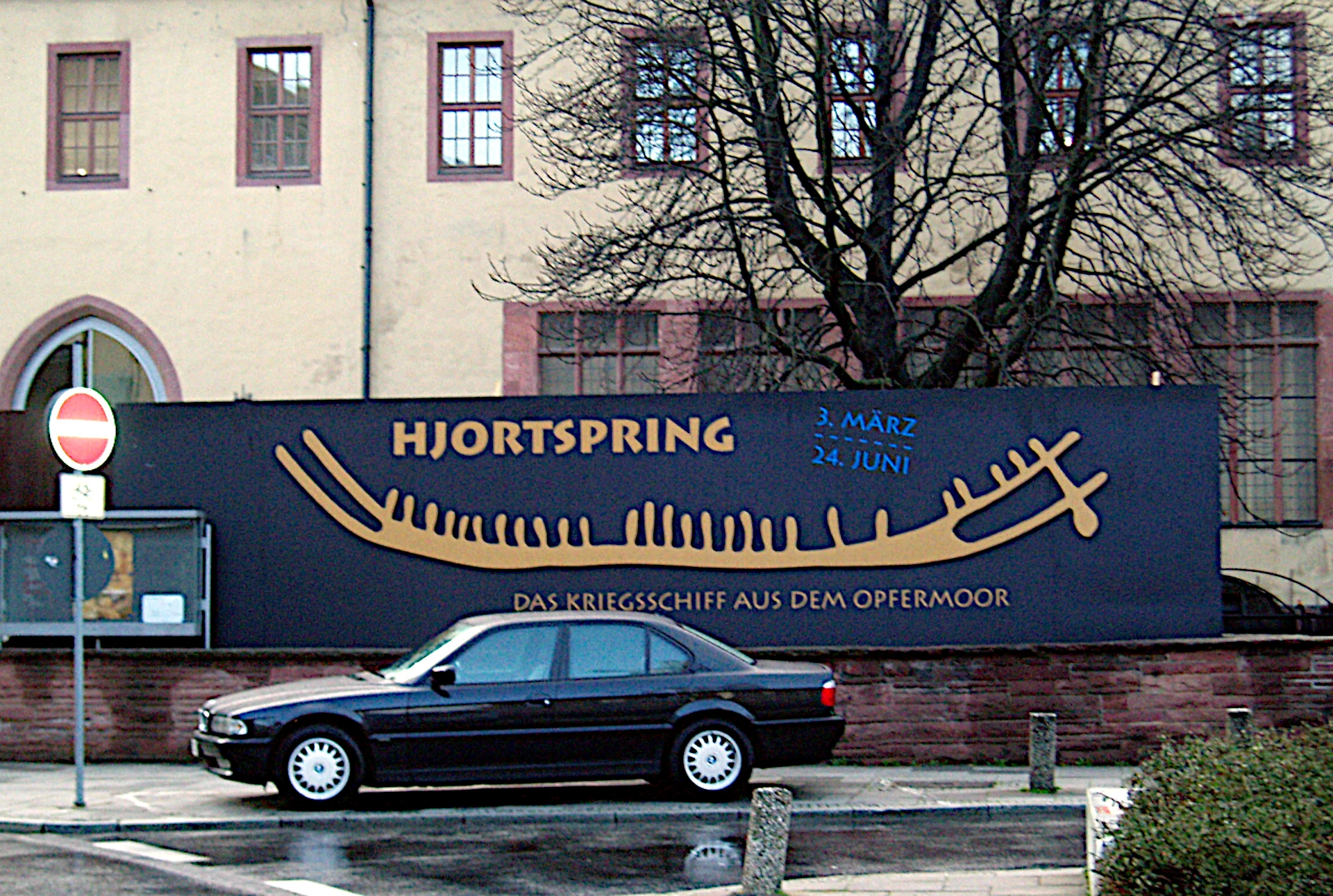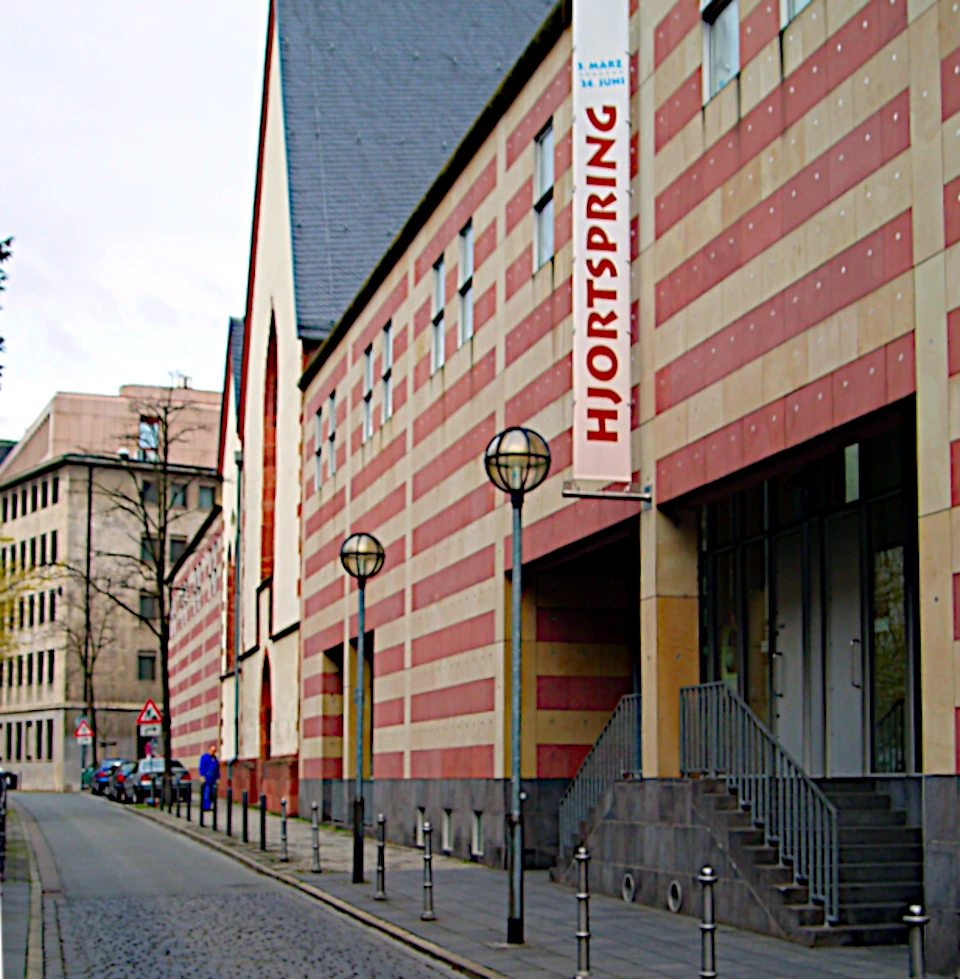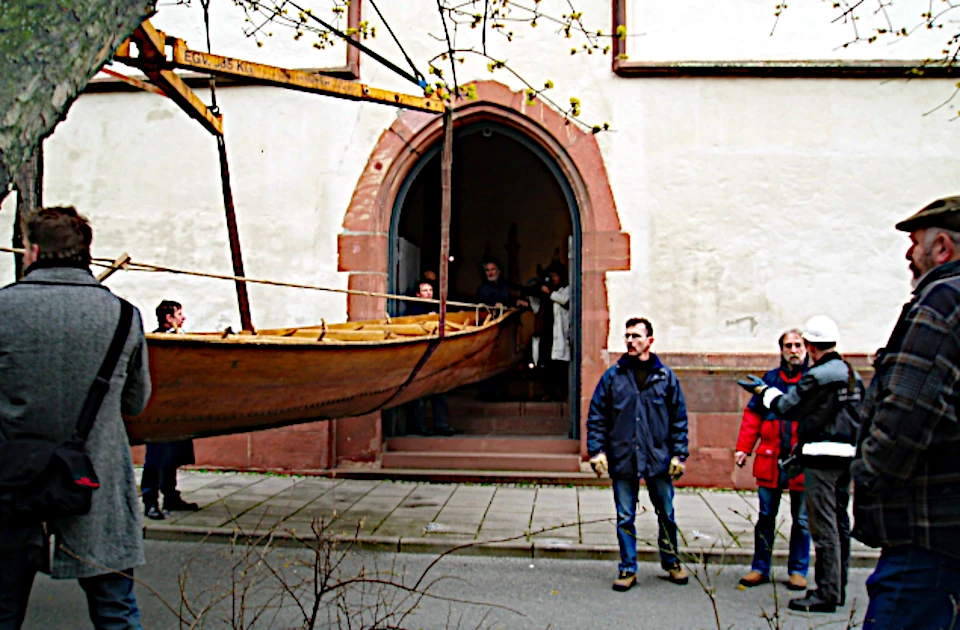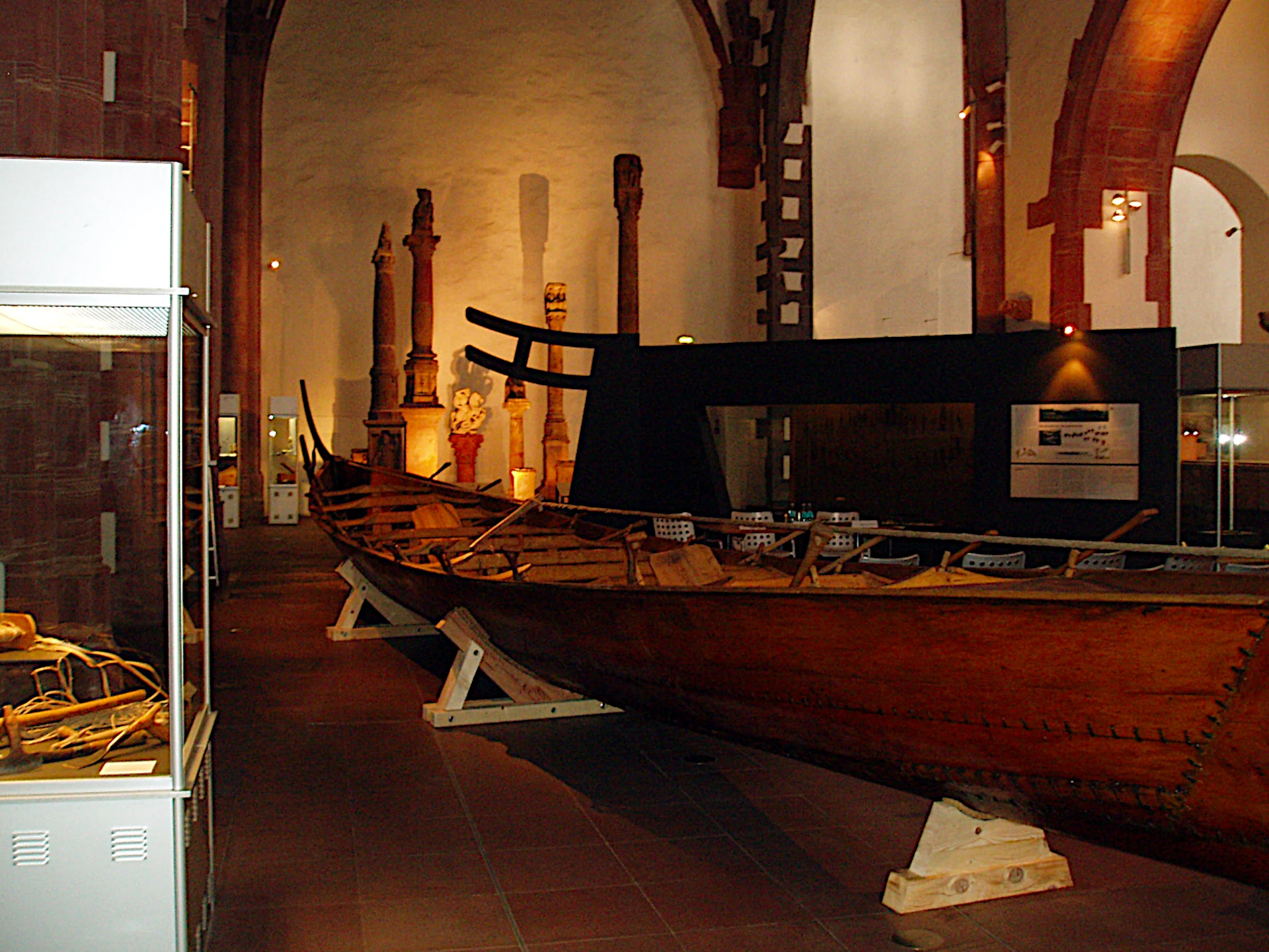In early July, 2007, Professor Dr Egon Wamers and J.J. Kær Rasmussen signed a contract to rent Tilia Alsie from 26 February to 30 June 2007. During this period, the boat will be on display at the Archaeological Museum Frankfurt. The title of the exhibition is ‘Hjortspring - das Kriegsschiff aus dem Opfermoor’.
Address:
Archäologisches Museum Frankfurt, Karmelitergasse 1,
60311 Frankfurt am Main,
www.archaeologishes-museum.frankfurt.de
Address:
Archäologisches Museum Frankfurt, Karmelitergasse 1,
60311 Frankfurt am Main,
www.archaeologishes-museum.frankfurt.de
Tilia to Frankfurt
As a prelude to Tilia's long journey to the Archäologisches Museum in Frankfurt, we had a visit to the Linde shipyard on Thursday 28 September from two employees of the museum to discuss the transport arrangements and how the boat could get into the museum's exhibition hall. The two men were called Thomas Flügen and Franz Martin and they were nice and pleasant to talk to.
We, Jørgen, Jørgen Anders, Arne, Knud A and Knud SR, received them in the club room, where we were shown drawings and photos of the facilities. The museum is housed in a former nunnery, and access was only possible through an entrance that was slightly narrower than Tilia and even over a pavement and up a staircase with three steps! And that was only if several metres of a hedge along a park were removed. As the lorry would arrive after the museum had closed, it had to be parked for the night in a small square nearby. And as the exhibition is due to open on 2 March, it is also possible that the winter weather could play tricks on us, so all in all, there were likely to be difficulties, but as we all know, they can only be overcome, so with great kindness from Franz and Thomas, the solutions were to put a guard at Tilia, to dig up the hedge, make a sloping chute for the stairs, remove the gate with frame and everything, and finally to move Tilia slightly to the side to reduce the width. And then do it all in reverse order when Tilia has to ‘sail’ home again. Speaking of sailing, it's not certain that there will be sailing on the Main, even though the river is close by, but we'll see about that later.
As mentioned, the opening will take place on 2 March and the association has been asked to give a speech about Tilia, and a volunteer crew will help with the ‘accommodation’.
Knud Skov Rasmussen
We, Jørgen, Jørgen Anders, Arne, Knud A and Knud SR, received them in the club room, where we were shown drawings and photos of the facilities. The museum is housed in a former nunnery, and access was only possible through an entrance that was slightly narrower than Tilia and even over a pavement and up a staircase with three steps! And that was only if several metres of a hedge along a park were removed. As the lorry would arrive after the museum had closed, it had to be parked for the night in a small square nearby. And as the exhibition is due to open on 2 March, it is also possible that the winter weather could play tricks on us, so all in all, there were likely to be difficulties, but as we all know, they can only be overcome, so with great kindness from Franz and Thomas, the solutions were to put a guard at Tilia, to dig up the hedge, make a sloping chute for the stairs, remove the gate with frame and everything, and finally to move Tilia slightly to the side to reduce the width. And then do it all in reverse order when Tilia has to ‘sail’ home again. Speaking of sailing, it's not certain that there will be sailing on the Main, even though the river is close by, but we'll see about that later.
As mentioned, the opening will take place on 2 March and the association has been asked to give a speech about Tilia, and a volunteer crew will help with the ‘accommodation’.
Knud Skov Rasmussen
On Monday 26 February in the year of our Lord 2007, ‘Tilia Alsie’ headed out from Holm bound for Frankfurt am Main with a 5-man crew consisting of the chairman, Jørn Anders, Arne and myself and our driver. However, Tilia did not follow the rivers and canals down through Germany, but with the help of the loading crane on an approx. 22 m long semi-trailer train was placed solidly on the semi-trailer bed, and was - solidly anchored here - transported along Autobahn 7 and 5 respectively the approx. 700 km to Frankfurt, where it arrived Wednesday morning at 09:30.
Only the driver was on board, while the rest of the crew was transported comfortably and dry in Arne's car; unlike Tilia, which in the absence of water to sail in got plenty of it from above, as it rained almost continuously during the entire trip down. As described above, we let Tilia sail its own lake aboard the lorry while we drove down at a comfortable Autobahn pace - much of the time more or less blind, as we had to pass through a cloud of water every time we overtook a bus or truck train, and there were a lot of them.
After a few short food and drink breaks along the way, we arrived at the ‘Archäologisches Museum’ in Frankfurt am Main around five o'clock on Monday afternoon and after meeting the museum director, Dr Wamers, and the other museum staff, we were accommodated at the Hotel Maingau, a quite acceptable hotel.
Only the driver was on board, while the rest of the crew was transported comfortably and dry in Arne's car; unlike Tilia, which in the absence of water to sail in got plenty of it from above, as it rained almost continuously during the entire trip down. As described above, we let Tilia sail its own lake aboard the lorry while we drove down at a comfortable Autobahn pace - much of the time more or less blind, as we had to pass through a cloud of water every time we overtook a bus or truck train, and there were a lot of them.
After a few short food and drink breaks along the way, we arrived at the ‘Archäologisches Museum’ in Frankfurt am Main around five o'clock on Monday afternoon and after meeting the museum director, Dr Wamers, and the other museum staff, we were accommodated at the Hotel Maingau, a quite acceptable hotel.
The next day after breakfast at the hotel, we went to the museum to await Tilia's arrival. The lorry arrived at the museum at around 09:30, but we had to wait to unload until 10:00, which was the agreed time for the press and TV to arrive.
After unloading, Tilia was moved into position on its trailer - by hand - in a very narrow passage along the side of the museum, after which our driver moved his front trailer into position so that he could lift Tilia with the loading crane, and after a few hectic hours we managed to get the boat edged in through the slightly too narrow gate, but we had to turn it almost completely on its side to get it in.
Tilia is now safe and sound in the main ship in an old monastery church, where it will remain until we pick it up again in late June.
On Wednesday morning, after saying goodbye to the museum staff, Jørn Anders, Arne and myself drove back home, while the chairman stayed behind to attend the opening of the exhibition on Friday.
Text and photos:
Knud Andersen
After unloading, Tilia was moved into position on its trailer - by hand - in a very narrow passage along the side of the museum, after which our driver moved his front trailer into position so that he could lift Tilia with the loading crane, and after a few hectic hours we managed to get the boat edged in through the slightly too narrow gate, but we had to turn it almost completely on its side to get it in.
Tilia is now safe and sound in the main ship in an old monastery church, where it will remain until we pick it up again in late June.
On Wednesday morning, after saying goodbye to the museum staff, Jørn Anders, Arne and myself drove back home, while the chairman stayed behind to attend the opening of the exhibition on Friday.
Text and photos:
Knud Andersen
Opening of the exhibition
”Hjortspring. Das Kriegsschiff aus dem Moor”
A testimonial
On Wednesday morning at around 8:45, I was standing in Berlinerstrasse looking for a taxi. A Saab drove past, in which Arne and Jørn Anders sat and waved. Knud drove according to the GPS guidance. I was on my way to Danfoss Offenbach, where I was shown around by the boss, Gerhard Bertelsen, with whom I had a chat about the upcoming exhibition and the opening event on Friday evening. I also got to meet C. J. Ringgård. Both of them and their wives were invited to the opening of the Archäologisches Museum-Frankfurt.
Later in the day I was at the museum where the two conservators from the National Museum, Gerd Elling and Anette Hjelm Petersen, were setting up the National Museum's exhibition of original artefacts from Hjortspring bog.
It was a beautiful display in the showcase that was used at the exhibition ‘The Triumph of Victory - Scandinavia in the Shadow of the Roman Empire’ in 2003 in Copenhagen. The display case has the shape of a stylised bow of a Hjortspring boat. On that occasion and in conversations with Anette and Gerd on Thursday, I learnt how objects are loaned from the National Museum: It is always people from the museum who bring or accompany loaned objects to other exhibition sites around the world, check the exhibition site (safety, humidity, temperature) and set up the loaned objects. They said that there is a lot of lending, which means a lot of travelling for some employees.
...
It was a beautiful display in the showcase that was used at the exhibition ‘The Triumph of Victory - Scandinavia in the Shadow of the Roman Empire’ in 2003 in Copenhagen. The display case has the shape of a stylised bow of a Hjortspring boat. On that occasion and in conversations with Anette and Gerd on Thursday, I learnt how objects are loaned from the National Museum: It is always people from the museum who bring or accompany loaned objects to other exhibition sites around the world, check the exhibition site (safety, humidity, temperature) and set up the loaned objects. They said that there is a lot of lending, which means a lot of travelling for some employees.
...
On Friday at 11am there was a press conference on the occasion of the exhibition. Professor Egon Wamers, Deputy Director of the National Museum of Denmark Per Kristian Madsen and I were the answer panel. 12-15 journalists and photographers were the questioners. I didn't understand their questions, so I was very grateful for the help of my fellow panellists (Egon Wamers speaks Norwegian). In the evening, people flocked to the event in large numbers. The opening took place with speeches by Egon Wamers, two cultural politicians from the county and city councils, myself and Per Kristian Madsen. Then I got into the boat to be able to explain and demonstrate my answers to all the questions that were asked for the next hour and a half.
I didn't realise that two guards were assigned to watch the boat and make sure people didn't touch it. One of the guards immediately got on my case. ‘I wasn't allowed to do that!’ I was very surprised and said ‘It's my boat!’ Then it was the guard's turn to look surprised.
It worked and with the help of Gerhard Bertelsen from Danfoss Offenbach I was able to convey a lot of knowledge about our project. The crew was really impressed by our project. For me it was very exciting.
The next day at 8.54am I got on the train to Flensburg.
J.J. Kjaer Rasmussen
I didn't realise that two guards were assigned to watch the boat and make sure people didn't touch it. One of the guards immediately got on my case. ‘I wasn't allowed to do that!’ I was very surprised and said ‘It's my boat!’ Then it was the guard's turn to look surprised.
It worked and with the help of Gerhard Bertelsen from Danfoss Offenbach I was able to convey a lot of knowledge about our project. The crew was really impressed by our project. For me it was very exciting.
The next day at 8.54am I got on the train to Flensburg.
J.J. Kjaer Rasmussen
Language
The text in this article has been translated from Danish to English using the free DeepL translation programme.








